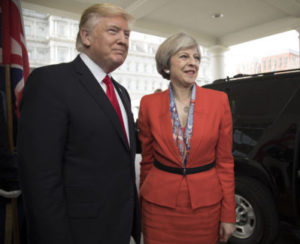
US-UK Trade: what’s in IT?
At the World Economic Forum meeting at Davos in January 2018 President Trump forecast a “tremendous” increase in trade between the US and the United Kingdom, presumably following Brexit. US Treasury Secretary Steven Mnuchin suggested that the UK would be at the head of the queue for a new trade agreement with the US. These statements contrast sharply with Trump’s general hostility to international trade deals (he has insisted on renegotiating the North American Free Trade Agreement, and withdrawn the US from the Trans-Pacific Partnership), and with earlier suggestions by other Administration officers that Britain was not a priority for US trade negotiations.
The US has no existing special trade agreement with the EU, and the hard-fought negotiations for a Transatlantic Trade and Investment Partnership – TTIP – are in the freezer having run into popular opposition on both sides of the Atlantic. Could President Trump’s statement provide a moment of opportunity for post-Brexit UK?
The bilateral relationship between the UK and the US matters a lot to the UK. The US is Britain’s second-biggest trade partner after the EU, accounting for some 15% of total UK exports. According to UN statistics, UK goods exports to the US in 2016 totalled $61.5 billion, against imports from the US of $57 billion. The US accounts for just under a quarter of UK services export (compared to around 35% for the EU). The US is the UK’s largest export market for some services exports, notably financial services.
The figures point to the potential of a bilateral deal. Estimates of how far free trade agreements of varying depth stimulate bilateral trade suggest that if the UK and the US were to conclude a free trade agreement resembling CETA, that could boost UK exports to the US by around 32%, or around $20 billion on current trends. The effects for services of such an agreement would be smaller – around 4%. A deeper agreement between the UK and the US, more along the lines of the depth of liberalisation seen in the single market, could have much stronger effects: an increase in goods and services exports of around 50%.
Is there an art to the deal?
These increases in trade would only come around once the agreement is negotiated and then implemented. Even if such a scenario looks more feasible than it currently does, it would take several years (the currently-suspended TTIP negotiations lasted for 4 years and are still incomplete).
Setting aside negotiating timelines, it also pays to examine what would go into an agreement between the UK and the US. Classical trade barriers – such as tariffs- are currently very low between the UK and the US outside a handful of sectors. The main focus of negotiations is likely to be on regulation, and this is also true of services.
Negotiating dynamics between the UK and US on regulation are unlikely to be balanced. The US market is five times that of the UK. The primary objective of American negotiators would be to ensure that UK regulations were more aligned to products and practices in the US. Given the relative size of the UK and the US it is hard to imagine that UK negotiators would have much success in changing American practices.
Issues include not only the currently much-discussed topics of access for US exports of chlorine-washed chicken, hormone-fed beef and genetically modified produce, but also privileged access for US firms to UK public procurement and regulatory standards, particularly in services. The regulation of financial services, audio-visual and the media sector, and data flows are likely to be particularly sensitive. US demands for preferential treatment in these areas may run into the sort of popular resistance that arose when they were considered within the scope of TTIP.
There is also a trade-off between any alignment of regulation with the US, and the extent of regulatory alignment with the EU, given the differences in approach between the US and the EU. For example, if the UK were to relax its approach towards the application of the precautionary principle and liberalise imports from the US of hormone-fed beef, the Government would also need to establish extra steps to demonstrate compliance of UK food exports with EU regulations and to avoid potential “leakage” of US-originating material into trade with the EU.
Coming up Trumps?
Any decision to enter into negotiations with the US, or indeed any other trade partner, would need to recognise these trade-offs. That makes the choice of trade negotiations one for careful analysis, rather than bold, simplistic declaration. Moreover, the fact that these trade-offs exist shows that leaving the EU is no guarantor of an “independent UK”. The importance of regulation and regulatory convergence in reducing trade costs means the UK will probably need to align itself to a major trade bloc.
Given the potential difficulties of alignment with the US, as illustrated above, and the absence of any other potential new partner of comparable weight and influence, the government’s current position, of prioritising deep integration with the EU seems sensible given the role of the EU in UK trade (which reflects size, proximity and past integration). That analysis could change, but basing UK policy on the expectation of a substantial increase in trade with the US – let alone a “tremendous increase” – in any other than the very long term would seem to be far-fetched.